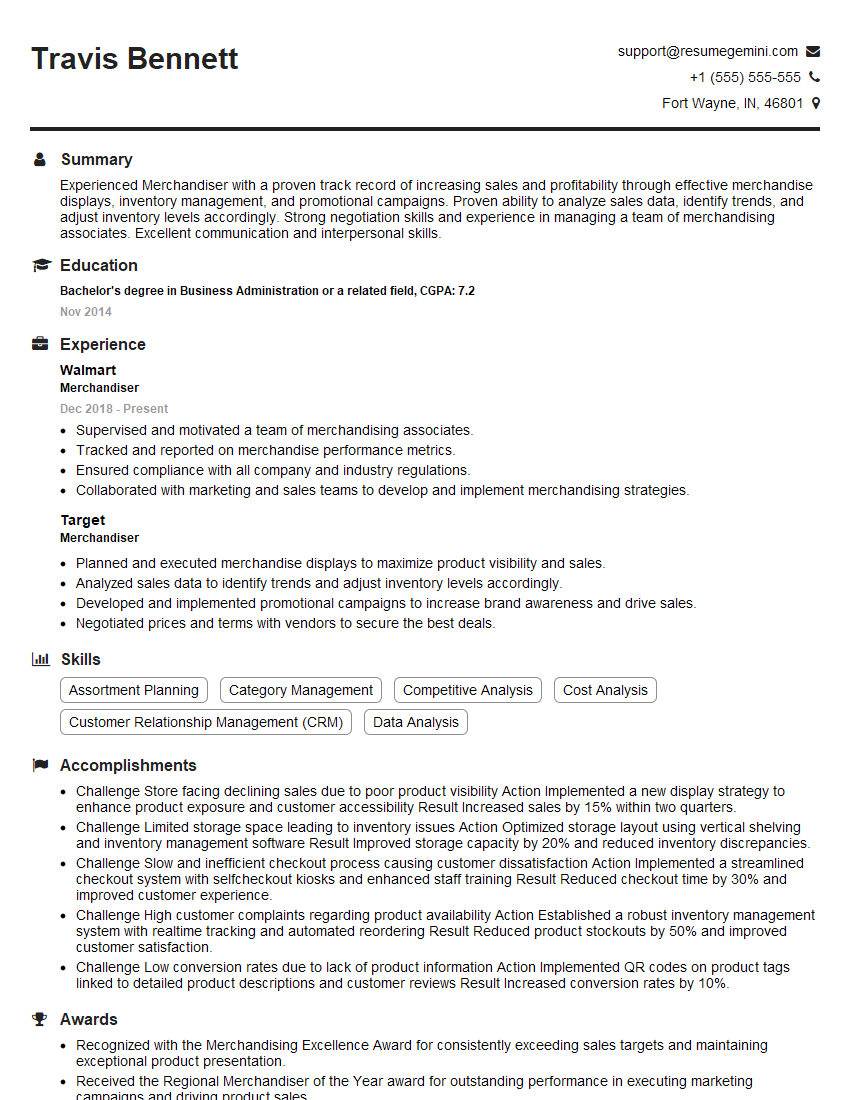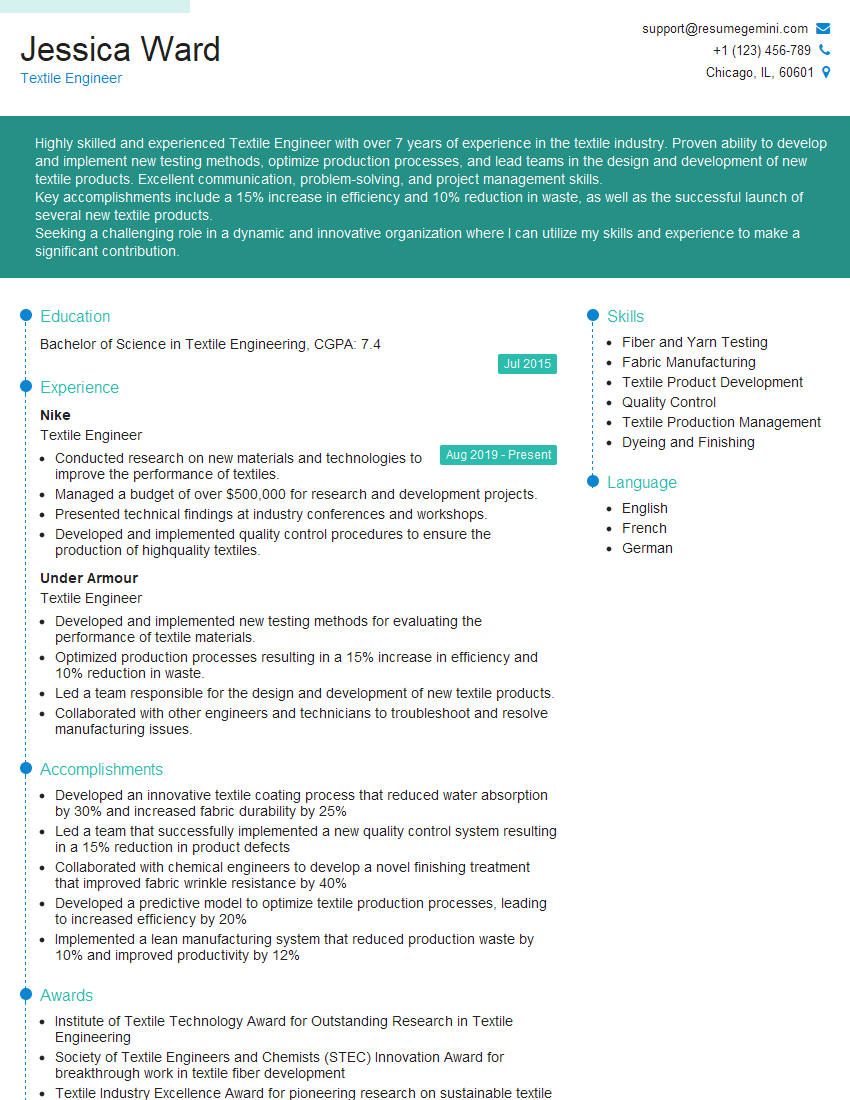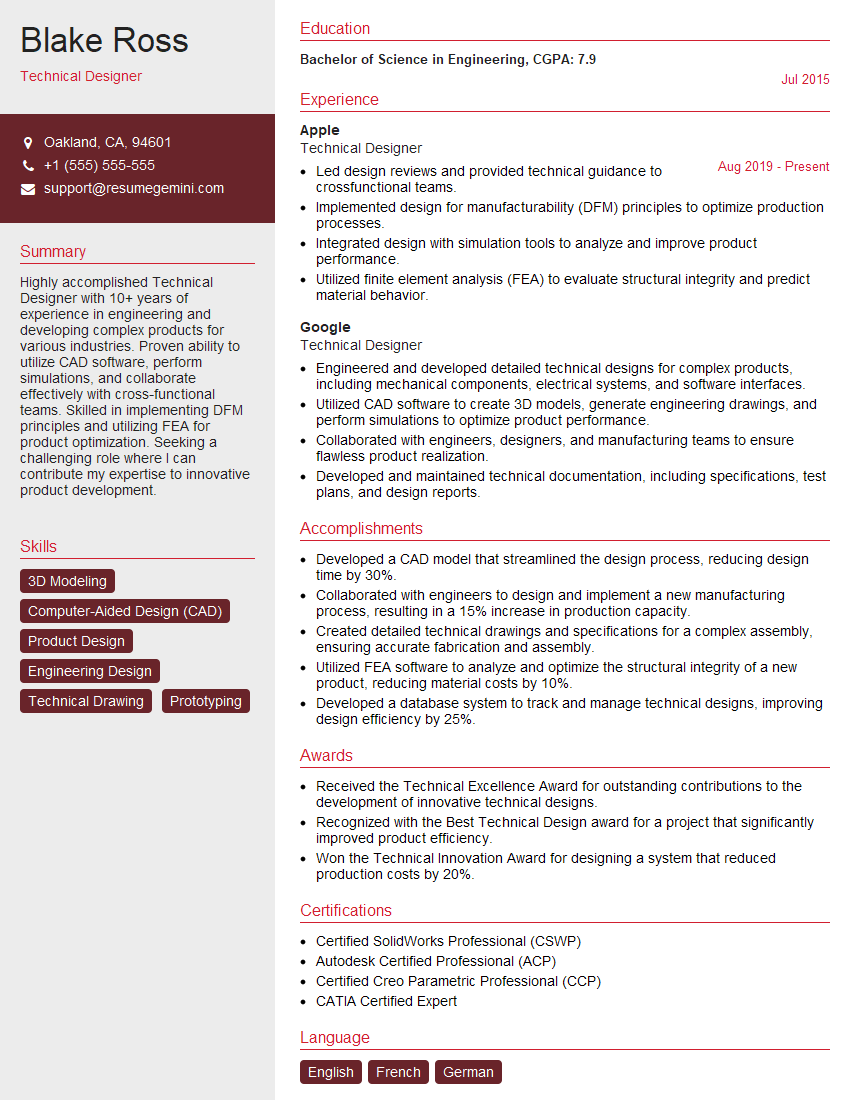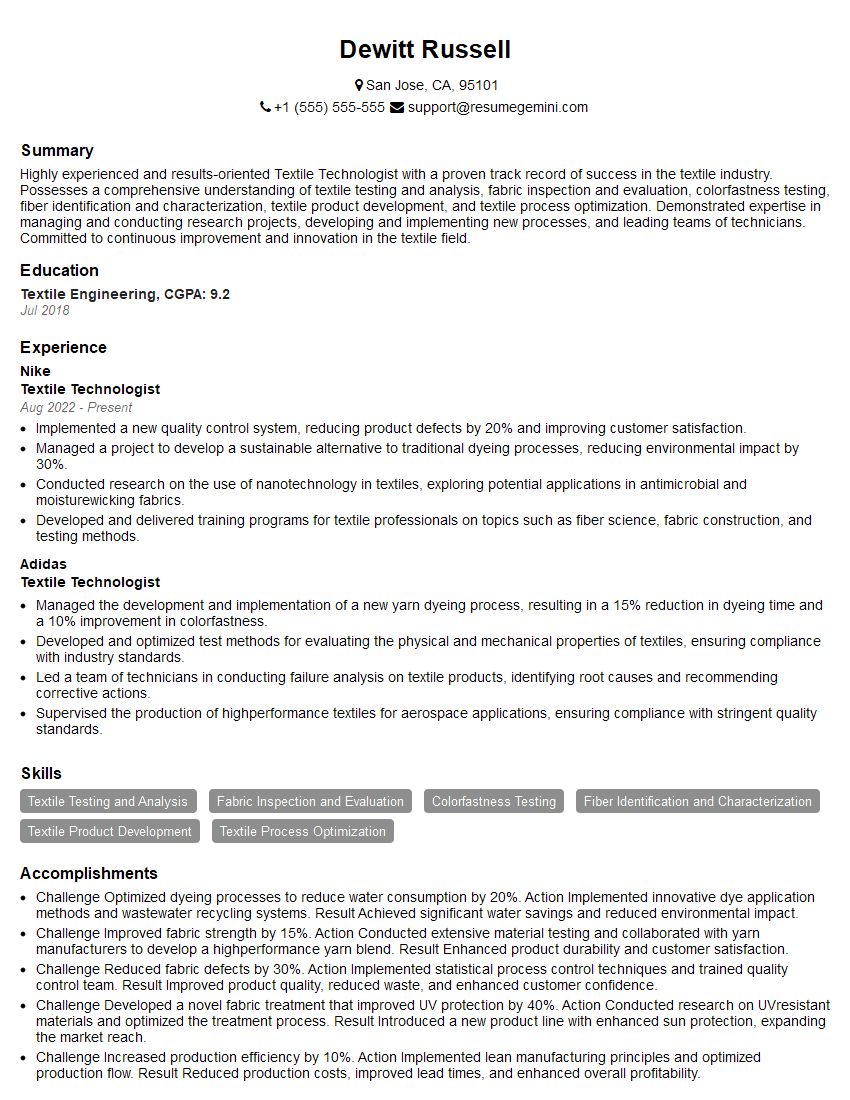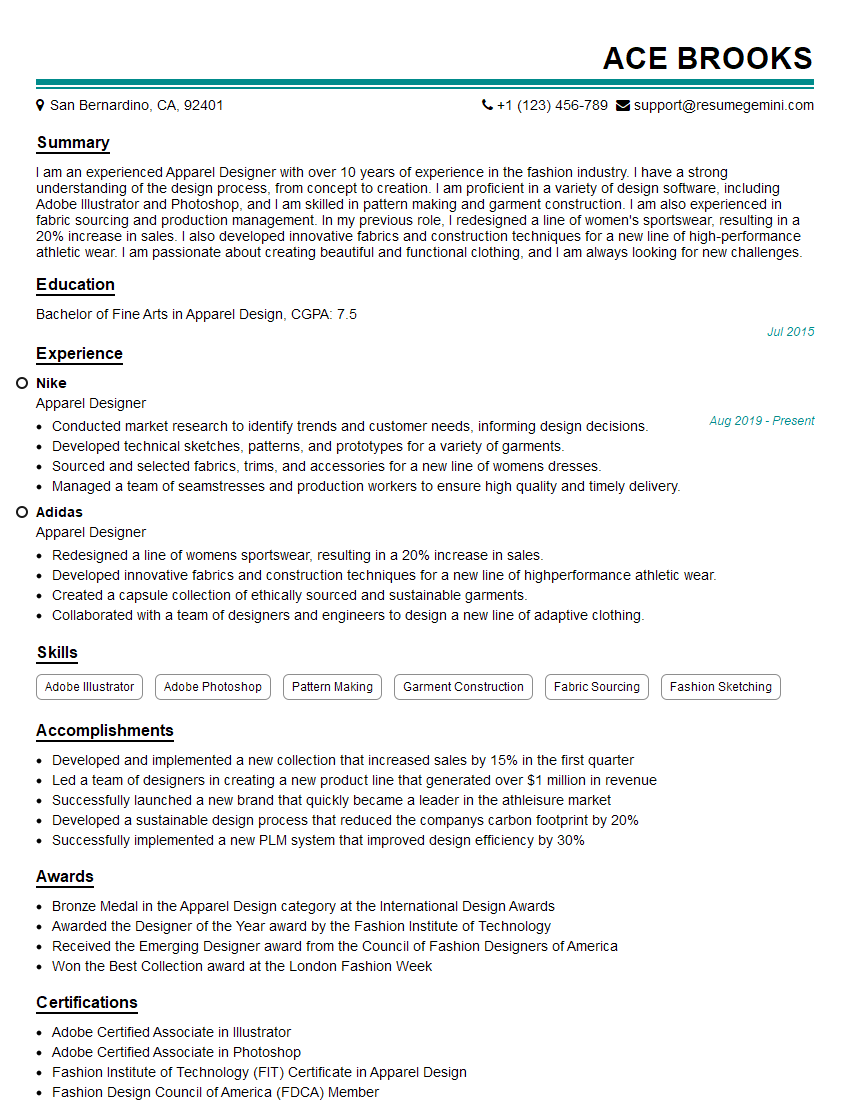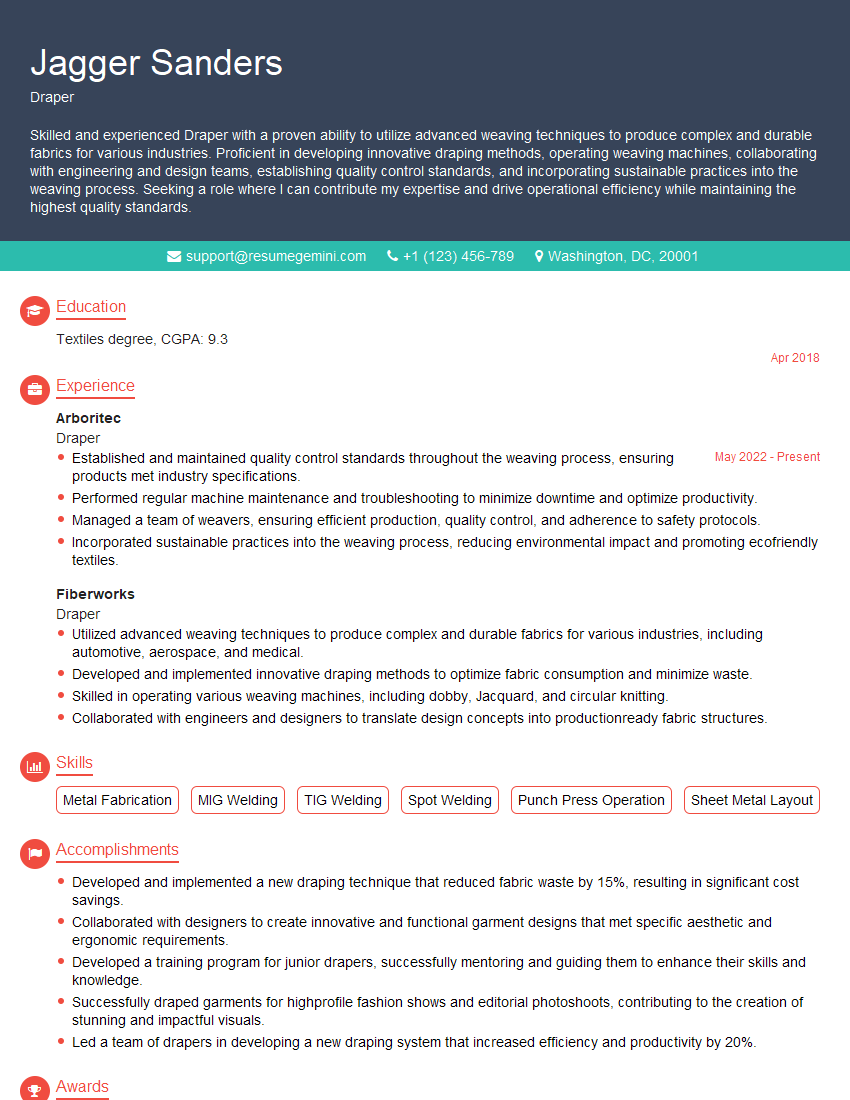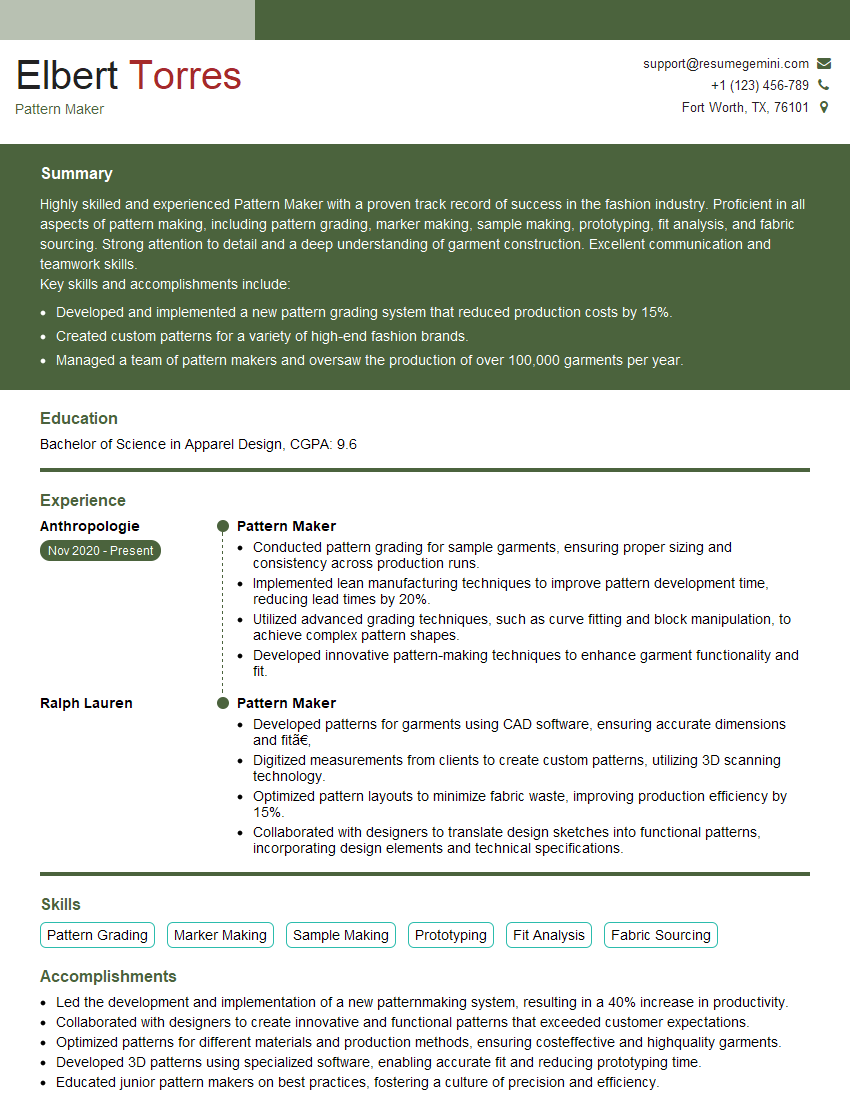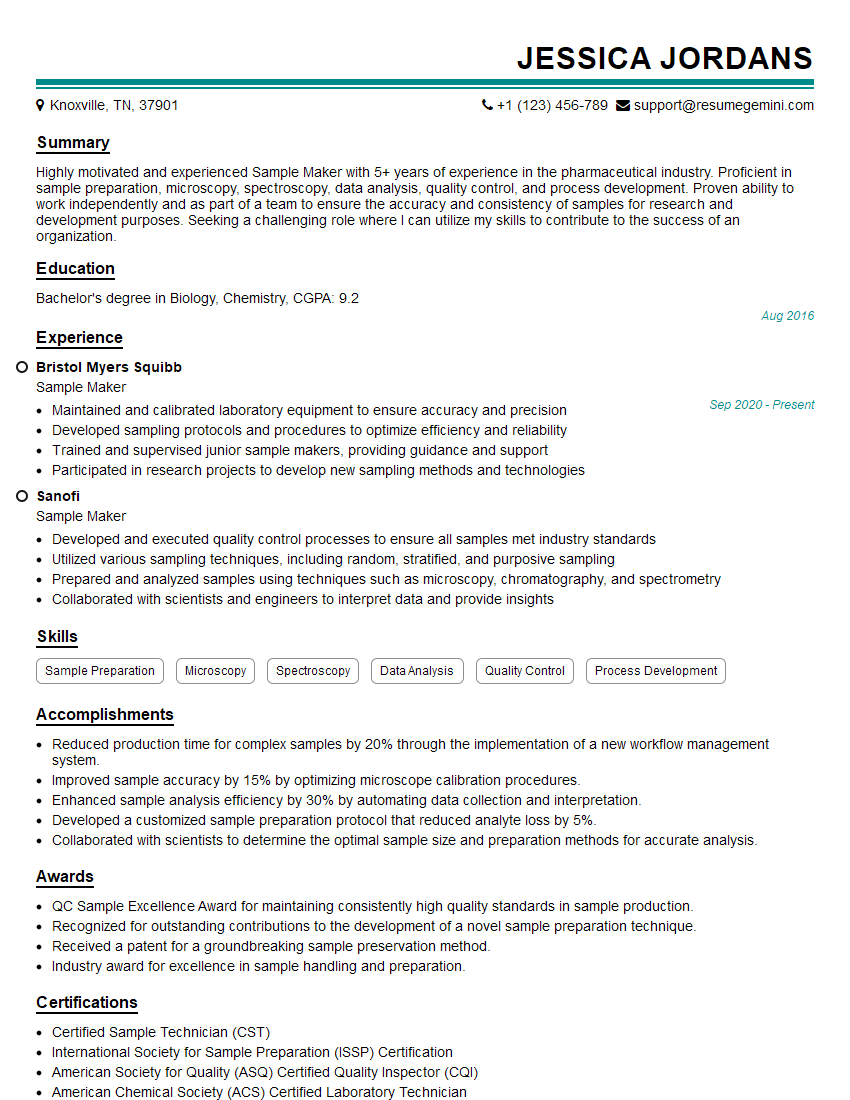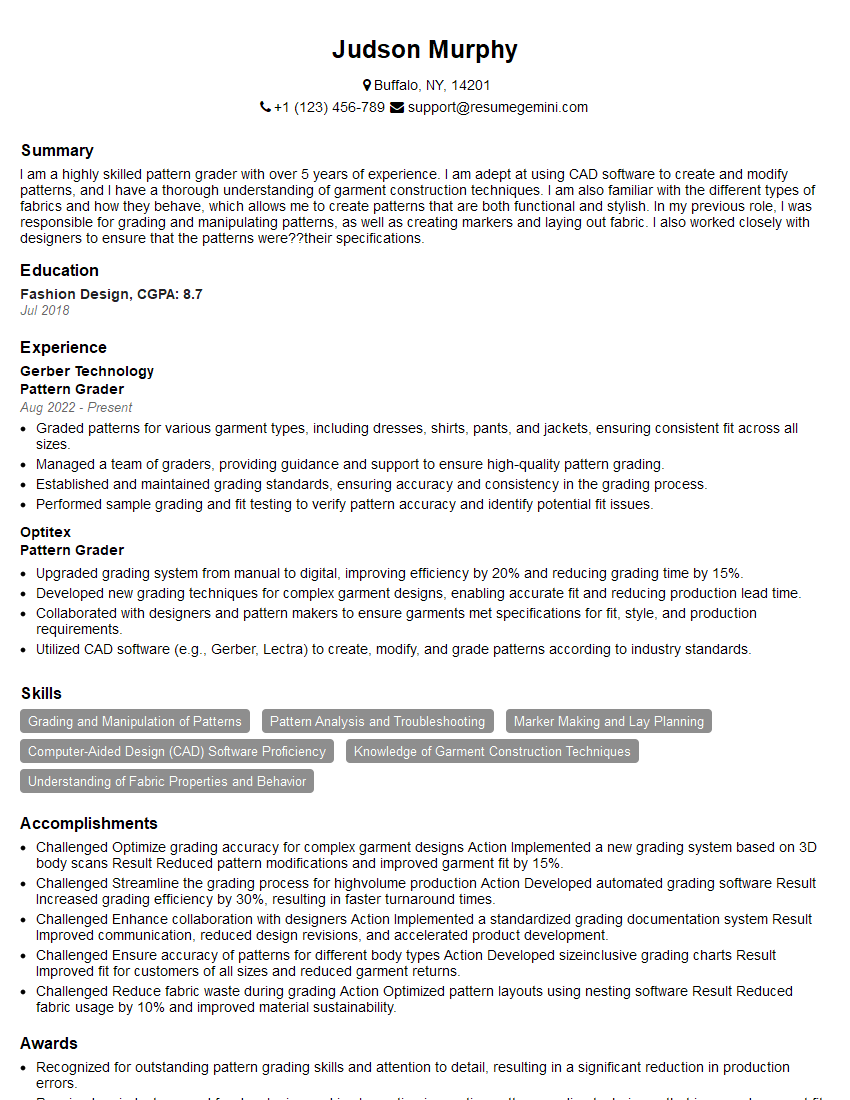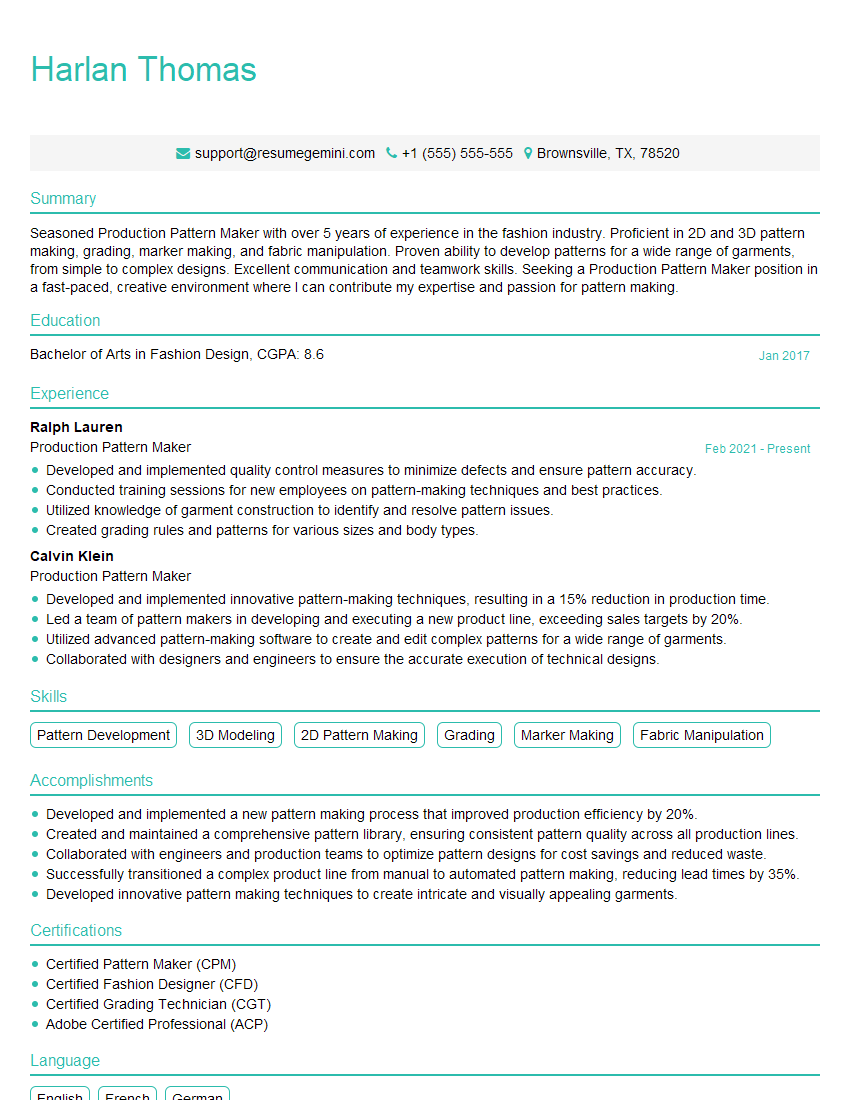The thought of an interview can be nerve-wracking, but the right preparation can make all the difference. Explore this comprehensive guide to Fabric Selection and Pattern Matching interview questions and gain the confidence you need to showcase your abilities and secure the role.
Questions Asked in Fabric Selection and Pattern Matching Interview
Q 1. Explain the difference between woven and knit fabrics.
Woven and knit fabrics are fundamentally different in their construction, leading to distinct properties. Woven fabrics are created by interlacing two sets of yarns—the warp (lengthwise) and weft (crosswise)—at right angles. Think of a traditional woven tapestry or a simple checkered tablecloth. This interlacing creates a strong, stable structure. Knit fabrics, on the other hand, are made by looping yarns together in a series of interconnected stitches. Imagine knitting a scarf—the continuous loops form the fabric. This looping process results in fabrics that are often more flexible and stretchy.
- Woven Fabrics: Stronger, more stable, less stretchy, often crisper drape, can be more resistant to snags, typically used for tailored garments like suits and shirts.
- Knit Fabrics: More flexible, stretchy, softer drape, prone to snagging, often used for casual wear like sweaters and t-shirts.
Consider the difference between a crisp cotton shirt (woven) and a soft cashmere sweater (knit). The woven shirt holds its shape better, while the knit sweater provides comfort and ease of movement.
Q 2. Describe the properties of cotton, silk, and polyester fabrics.
Cotton, silk, and polyester represent a spectrum of fabric properties, each suitable for different applications.
- Cotton: A natural fiber, cotton is known for its breathability, absorbency, and softness. It’s relatively inexpensive and easy to care for, making it a popular choice for everyday wear. However, it can wrinkle easily and shrink after washing.
- Silk: A luxurious natural fiber, silk is renowned for its smoothness, sheen, and drape. It’s exceptionally comfortable but delicate, requiring careful handling and dry cleaning. Silk’s high cost and special care requirements limit its use in certain projects.
- Polyester: A synthetic fiber, polyester is durable, wrinkle-resistant, and relatively inexpensive. It’s often blended with other fibers to enhance their properties, such as adding wrinkle resistance to cotton or making a silk-like blend more affordable. However, polyester is less breathable than natural fibers and can feel less soft against the skin.
For example, a summer dress might be made from breathable cotton, a formal evening gown from luxurious silk, and a durable travel jacket from a polyester blend.
Q 3. How do you select the appropriate fabric for a specific garment design?
Fabric selection is crucial for a garment’s success. The choice depends heavily on the design, intended use, and target audience. Consider these factors:
- Garment Style: A flowing gown needs a drapey fabric like silk or chiffon, while a structured blazer requires a stable fabric like wool or linen.
- Intended Use: A performance athletic wear requires moisture-wicking fabrics, whereas a cozy sweater demands a warm and soft material.
- Season: Lightweight fabrics are appropriate for summer, while heavier fabrics are better suited for winter.
- Budget: Fabric costs vary widely; selecting a fabric within the budget is essential.
- Care Instructions: Consider the ease of care—a fabric requiring dry cleaning may not be practical for a frequently worn item.
For instance, designing a summer blouse, I’d choose a lightweight cotton or linen for its breathability and comfort. But for a winter coat, I’d select a heavier wool or a water-resistant fabric.
Q 4. What are the key factors to consider when matching patterns across seams?
Matching patterns across seams is essential for a professional-looking garment. Key considerations include:
- Pattern Direction: Ensure the pattern flows consistently across seams, following the grain line. This is crucial to prevent distortion and maintain the design’s integrity.
- Matching Points: Identify key design elements (like large motifs, stripes, or plaids) and align them meticulously across seams. This may require extra fabric to ensure perfect alignment.
- Seam Allowance: Account for seam allowance when matching patterns to avoid errors.
- Fabric Type: Matching can be more challenging with fabrics that stretch or have directional patterns.
- Pattern Scale: For larger, bolder prints, the matching process requires extra precision and might involve more complex cutting techniques.
For example, when working with a plaid fabric, careful planning and alignment are crucial to ensure the plaid lines up perfectly at the shoulder seams and center front.
Q 5. Explain the process of creating a basic block pattern.
A basic block pattern is a foundational pattern representing the body’s basic shape. It serves as the starting point for designing various garments. The process usually involves:
- Measurements: Taking accurate body measurements is the first step. This data forms the basis for the block.
- Drafting: Using these measurements, the pattern pieces (front and back bodice, sleeves) are drafted onto paper. This often involves mathematical calculations and pattern drafting techniques. Accurate calculations are crucial for a well-fitting pattern.
- Adjustments: The initial drafted block is often adjusted to reflect individual body characteristics, like posture or different torso lengths. These adjustments may include adding ease (extra fabric for comfort and movement).
- Testing: The block is then tested by creating a muslin (a test garment) and making any necessary alterations for a better fit before using the final fabric.
The basic block provides a personalized foundation, making subsequent garment design faster and more accurate. It’s akin to building a house—you wouldn’t start building walls without a solid foundation.
Q 6. How do you grade a pattern to different sizes?
Grading a pattern involves adjusting the pattern pieces to create different sizes. This can be done manually or using specialized software. Manual grading involves adding or subtracting measurements systematically across the pattern pieces based on size charts. Each size increment is carefully calculated. Software automates this process, ensuring consistent and accurate sizing.
- Manual Grading: This requires a deep understanding of body proportions and pattern construction. It’s precise but time-consuming.
- Software Grading: CAD (Computer-Aided Design) software simplifies the process, significantly reducing time and potential errors. Software allows for precise adjustments and easy scaling.
For example, grading a size 8 pattern to a size 12 involves increasing measurements proportionally across all pattern pieces. Without precise grading, the finished garment may be ill-fitting and out of proportion.
Q 7. What software are you proficient in for pattern making and design?
I am proficient in several software packages used in pattern making and design. My expertise includes:
- Adobe Illustrator: Excellent for creating and manipulating vector graphics, ideal for technical drawings and pattern design.
- CLO 3D: A powerful 3D apparel design software that allows for virtual fitting and prototyping, reducing the need for numerous physical samples.
- Pattern Design Software (e.g., OptiTex, Lectra): These specialized software packages provide advanced tools for grading, nesting patterns, and managing pattern libraries. They streamline workflows and enhance efficiency.
My experience with these programs allows me to seamlessly transition between 2D and 3D design, ensuring accuracy and efficiency in my projects. This combination of technical skills ensures I can meet the demands of any design challenge effectively.
Q 8. Describe your experience with different types of pattern pieces (e.g., darts, pleats).
Pattern pieces are the individual shapes that, when sewn together, create a garment. Understanding their nuances is crucial. Darts, for example, are used to shape fabric and create curves, such as those found at the bust or waist. They’re essentially folded triangles of fabric that are sewn closed to reduce fullness. Different dart placements and shapes achieve different effects. A bust dart, for example, creates a fitted bustline while a waist dart shapes the waist. Pleats, on the other hand, are folds of fabric that are usually left open and stitched down to create texture and volume. They can be knife pleats (single folds), box pleats (two folds), or inverted pleats, each significantly impacting the final garment’s drape and silhouette. I have extensive experience working with various dart and pleat types, including French darts, princess seams (which essentially function as elongated darts), box pleats, knife pleats, and inverted box pleats, adapting them to different fabrics and garment styles. For instance, I’ve successfully incorporated multiple cleverly placed darts into a structured wool coat to achieve a beautifully fitted silhouette, while using box pleats in a lightweight silk blouse to add elegance and movement.
- Darts: Used to shape and fit the garment.
- Pleats: Used for decoration and adding volume.
- Other pieces: Facings, collars, cuffs, pockets each require distinct considerations during construction.
Q 9. How do you handle pattern alterations for fit adjustments?
Pattern alterations for fit adjustments are a core part of my work. It’s rarely the case that a pattern fits perfectly ‘off-the-rack,’ so understanding how to make adjustments is critical. This begins with careful fitting of the initial pattern on the client or model. Common alterations involve easing out the shoulder, adjusting the bust or waist circumference, lengthening or shortening the garment, and manipulating the sleeve cap height or width. I usually tackle these using a combination of techniques including adding or removing wedges, shifting seam lines, or adjusting ease. For example, if a garment is too tight across the bust, I might add a small wedge to the front bodice pattern piece, distributing the added space evenly. If it’s too long, I simply shorten the pattern piece along the desired seamline. Accurate measurement and meticulous attention to detail are crucial, always considering how the alteration might impact other areas of the garment. I frequently utilize tissue paper to test adjustments before cutting into expensive fabrics. This allows for error correction and refinement of the design.
Q 10. How do you ensure accurate pattern matching on complex garments?
Accurate pattern matching on complex garments requires careful planning and execution. Before cutting, I always thoroughly examine the fabric for its print, grain, and nap. Understanding the fabric’s directional properties is key. Then, I meticulously plan the layout of pattern pieces on the fabric, ensuring that directional patterns (e.g., stripes, plaids) line up consistently across seams and prominent design features. For symmetrical garments, I often use the fold of the fabric as a guide for mirroring patterns. For complex patterns with multiple pieces, I might create a detailed cutting layout sketch beforehand, to minimize fabric waste and maximize alignment. This helps avoid unsightly mismatches and maintain the garment’s aesthetic integrity. If a pattern needs to be repeated, I use carefully measured markers and chalk lines to ensure the pattern matches seamlessly. Pinning is also critical and should be meticulous to avoid accidental shifts during cutting.
Q 11. What are the common challenges in fabric selection and how do you overcome them?
Fabric selection is critical and presents several challenges. The biggest is matching the fabric’s properties (weight, drape, stretch, texture) to the design and intended use of the garment. A lightweight silk would be inappropriate for a winter coat, while a heavy wool would be too stiff for a flowing summer dress. Another challenge is understanding how fabric will behave during construction. Some fabrics fray easily, others shrink significantly after washing, and some can be difficult to sew due to their texture or properties. Overcoming these challenges involves extensive knowledge of different fabric types and their characteristics. I always source samples and test them before committing to a large order. This allows me to assess drape, sewability, and shrinkage potential. Thorough research on fabric content and care instructions is equally vital. Understanding how different fabrics react to pre-washing and specific treatments informs my selection process and avoids post-construction disappointments. For instance, if a client selects a fabric prone to shrinkage, I’ll recommend pre-washing and carefully adjust the pattern accordingly.
Q 12. Describe your experience with different fabric draping techniques.
Draping is a crucial technique for creating garments directly on a dress form. My experience with various draping techniques ranges from basic muslin draping to sophisticated sculptural forms. I am skilled at using different fabrics to create various effects. For instance, using a lightweight chiffon allows me to create soft, flowing shapes, while a heavy brocade results in more structured designs. I understand the interplay between fabric weight, drape, and the manipulation needed to achieve specific silhouettes. I typically begin draping with muslin, which is inexpensive and easy to manipulate, allowing me to experiment and refine the design before cutting into the final fabric. Draping allows for highly personalized fits, making it ideal for unique or bespoke creations where standard patterns may not suffice. For example, I recently draped a complex evening gown on a mannequin, using layers of silk to create intricate pleats and a flowing train. This approach allowed me to achieve a level of fit and design that would be impossible to replicate using only pattern-making techniques.
Q 13. Explain the importance of seam allowances in pattern making.
Seam allowances are the extra fabric included beyond the seam line for sewing. They’re critical for several reasons. Primarily, they provide the necessary fabric to complete the seam and allow for adjustments during construction. An inadequate seam allowance can lead to seams that are too narrow, making alterations impossible or resulting in a poorly fitting garment. Conversely, excessively large seam allowances can cause bulkiness and alter the garment’s intended shape. Standard seam allowances vary based on the garment type and fabric, usually ranging from 5/8” to 1 ½”. The pattern should always clearly indicate the required seam allowance, and precise cutting and sewing is crucial to maintain consistency across the garment. Consistent seam allowances are key to achieving a professional finish and a well-constructed garment. They also leave room for potential alterations or adjustments if needed during the fitting process. An insufficient seam allowance leaves little to no room for adjustments, limiting options for altering the garment.
Q 14. How do you adjust patterns for different fabric weights?
Adjusting patterns for different fabric weights requires understanding how the fabric’s weight impacts the garment’s drape and construction. Heavier fabrics, such as heavy wool or brocade, require more structural support. This might involve adding interfacing to stabilize the fabric, modifying the pattern to reduce ease, or altering the seam allowance. Lighter fabrics, such as silk or chiffon, tend to drape more easily. These might need adjustments to accommodate their flow and prevent unwanted sagging. This could involve adding darts to shape the garment better, using lighter interfacing if needed, or adjusting the placement of design details to enhance drape. The adjustment strategy involves considering how the fabric will respond to different design features, which might necessitate changing the pattern’s shape, adding design elements for structural support, or even choosing different construction techniques. For example, a heavy fabric might require more structured seams, whereas a lightweight fabric might benefit from French seams or other finishes that minimize bulk and maximize drape. This process requires a keen eye for detail and a thorough understanding of fabric properties.
Q 15. What are the different types of pattern cutting techniques?
Pattern cutting techniques are the foundation of garment construction, dictating the shape and fit of a garment. Different techniques are employed depending on the desired style, fabric, and fit. Here are some key methods:
- Draping: This is a three-dimensional method where fabric is draped on a dress form to create the desired shape. It’s ideal for creating unique, flowing designs and is particularly useful for understanding how fabric behaves.
- Flat Pattern Cutting: This is a two-dimensional method where patterns are created on paper or using CAD software. Measurements are taken, and the pattern pieces are drafted based on these measurements and the desired style. This is widely used for its precision and reproducibility.
- Block Drafting: This involves creating a basic pattern block (a simplified, fitted pattern) from which various styles can be derived. This foundational block is adjusted to create different designs.
- Grading: This is the process of adjusting the pattern to accommodate different sizes. It’s essential for mass production and ensuring a consistent fit across size ranges.
- Notching and Marking: This crucial step involves adding notches and markings to the pattern pieces to indicate where seams, darts, or other design elements should be placed. It aids in the accurate assembly of the garment.
For example, draping is frequently used in high-fashion design for its ability to capture unique silhouettes, while flat pattern cutting is preferred in mass production due to its efficiency and consistency. The choice of technique often depends on factors such as the complexity of the design, the available resources, and the desired level of customization.
Career Expert Tips:
- Ace those interviews! Prepare effectively by reviewing the Top 50 Most Common Interview Questions on ResumeGemini.
- Navigate your job search with confidence! Explore a wide range of Career Tips on ResumeGemini. Learn about common challenges and recommendations to overcome them.
- Craft the perfect resume! Master the Art of Resume Writing with ResumeGemini’s guide. Showcase your unique qualifications and achievements effectively.
- Don’t miss out on holiday savings! Build your dream resume with ResumeGemini’s ATS optimized templates.
Q 16. Describe your experience using a CAD system for pattern making.
I have extensive experience using CAD systems for pattern making, primarily using [Name of CAD software – e.g., Gerber Accumark, Optitex]. My proficiency encompasses all aspects, from initial design sketching and measurement input to grading and generating production-ready marker layouts. I’m comfortable with features such as:
- Digitizing existing patterns: Converting physical patterns into digital formats for easier manipulation and storage.
- Pattern drafting and manipulation: Using CAD tools to precisely adjust pattern pieces, including adding design details, shaping curves, and creating design variations.
- Grading: Automating the process of adjusting pattern sizes across a range of measurements.
- Marker making: Optimizing fabric layout on the pattern to minimize waste and improve efficiency.
In a recent project, I used CAD software to design a complex, asymmetrical dress. The software’s ability to manipulate curves and create intricate details enabled me to refine the design efficiently, leading to a more precise and aesthetically pleasing final product. My experience also extends to using CAD for generating technical design specifications and collaborating with production teams.
Q 17. How do you check for pattern errors before cutting fabric?
Checking for pattern errors before cutting fabric is crucial to avoid costly mistakes and wasted materials. My process involves multiple checks at different stages:
- Visual Inspection: Carefully examining the pattern pieces for any obvious errors, such as mismatched seams, incorrect grainlines, or missing markings.
- Test Assembly: Cutting out a test garment from inexpensive fabric to check the fit and identify any issues with the pattern before cutting the final fabric. This helps catch errors in design and construction before significant material is used.
- Measurement Verification: Verifying all measurements against the original specifications and making sure all pattern pieces correctly match each other to ensure proper assembly. This frequently uses tools like rulers and measuring tapes.
- Grain Line Alignment: Ensuring the grainlines (the lengthwise and crosswise yarns) are aligned correctly on each piece, particularly important for fabrics with directional patterns or drape.
- Symmetry Check: For symmetrical designs, carefully check if both halves are identical and mirrored properly. This includes a close examination of the pattern markings and notches.
By combining these checks, I can significantly reduce the chance of errors and ensure a smooth and efficient production process. A simple oversight can lead to hours of rework, so a methodical approach is paramount.
Q 18. What methods do you use to ensure accurate pattern placement?
Accurate pattern placement is essential for achieving the intended design and ensuring that the final garment looks as planned, especially crucial when working with patterned fabrics. Here’s my approach:
- Understanding Fabric Grain: Before placement, I carefully examine the fabric to identify the warp (lengthwise) and weft (crosswise) yarns. Alignment with the pattern pieces’ grainlines is paramount.
- Pattern Matching Techniques: I utilize various techniques, depending on the fabric pattern. For small, repeating prints, I create a layout plan to ensure seamless transitions and avoid abrupt pattern interruptions. For larger, bolder prints, careful consideration is given to the placement of the pattern’s focal point within the garment.
- Using Templates and Guides: Using templates and straight pins for consistent spacing and alignment. This approach is particularly useful for complex patterns or large fabric pieces.
- Marking and Notching: Precisely marking fabric pieces for alignment and utilizing notches on patterns for precise seam placement.
- Consideration for Nap and Direction: For fabrics with nap (a directional surface texture, like velvet), I ensure the nap is consistent across all pieces. The nap’s direction influences the fabric’s drape and appearance, and consistent direction is critical for a professional finish.
For example, when working with a floral print, I might create a layout that ensures the flowers align seamlessly across seams, enhancing the aesthetic appeal of the final garment.
Q 19. How do you manage multiple pattern projects simultaneously?
Managing multiple pattern projects concurrently requires a well-organized and efficient approach. I use a combination of techniques to maintain productivity and avoid errors:
- Prioritization: I prioritize projects based on deadlines, urgency, and complexity. This ensures I focus on the most critical tasks first.
- Project Tracking System: I use a project management system (e.g., Trello, Asana) to track the progress of each project, including deadlines, milestones, and task assignments. This enables efficient monitoring of several projects simultaneously.
- Detailed Documentation: I maintain meticulous documentation for each project, including sketches, specifications, and pattern pieces. This allows me to easily switch between projects without losing context.
- Dedicated Workspace: I dedicate specific areas for different projects to avoid confusion and maintain a clear working environment. This reduces the likelihood of mixing up pattern pieces or other project elements.
- Regular Review and Adjustment: I regularly review my project schedule and make necessary adjustments as needed to ensure I’m on track and effectively managing my workload.
This structured approach helps prevent project overlap and ensures consistent quality across all my engagements. Effective time management and prioritization are crucial for success in handling multiple projects simultaneously.
Q 20. Explain your understanding of different types of pattern grading.
Pattern grading is the process of scaling a base pattern to create different sizes. This is essential for mass production, as it ensures consistent fit across a range of body measurements. Several grading methods exist:
- Manual Grading: This traditional method involves manually adjusting the pattern pieces using rulers and other tools. It’s more time-consuming but offers greater control over the design.
- Computer-Aided Grading (CAG): This method uses specialized software to automatically scale and adjust patterns, significantly improving efficiency and consistency. This is often faster and less prone to errors than manual grading.
- Proportional Grading: This involves scaling the pattern pieces proportionally based on a set of grading rules. It’s a simple method but may not always result in the best fit, especially for complex garments.
- Non-Proportional Grading: This method allows for adjusting individual pattern pieces in non-proportional ways to accommodate varying body shapes. It requires advanced understanding of the body’s measurements and how they affect fit.
The choice of grading method often depends on the complexity of the design, the required accuracy, and the available resources. For example, manual grading might be preferred for high-end garments where precise fit and customization are paramount. CAG is a more practical and scalable approach in mass production for its speed and efficiency.
Q 21. Describe your problem-solving skills related to pattern matching discrepancies.
Pattern matching discrepancies can arise from various factors, including inaccurate measurements, improper fabric handling, or mistakes in pattern cutting. My problem-solving approach is systematic and focuses on identifying the root cause:
- Careful Examination: I start by carefully examining the affected areas of the garment to identify the nature and extent of the discrepancy. Pinpointing the location and nature of the problem is crucial.
- Review of Pattern Pieces: I revisit the pattern pieces to check for any errors in cutting, marking, or notching. This helps determine if the problem originated during the pattern making stage.
- Fabric Inspection: I inspect the fabric for any inconsistencies, such as variations in weave or print, which could have contributed to the matching issues.
- Re-cutting and Re-assembly: Depending on the severity of the error, I may re-cut the affected pieces or the entire garment to correct the discrepancy. If the error is minor, adjustments can be made using hand sewing or alterations.
- Process Adjustment: I refine my processes to prevent similar errors from recurring. This may involve improving my pattern making techniques, better planning for fabric layout, or developing more robust quality control checks.
For instance, if a seam doesn’t match in a patterned fabric, I might investigate whether the fabric was incorrectly aligned during cutting, or whether the pattern pieces were incorrectly cut. By thoroughly investigating the root cause, I can find an efficient and effective solution.
Q 22. How do you communicate effectively with designers and production teams regarding pattern specifications?
Effective communication with designers and production teams regarding pattern specifications hinges on clarity, precision, and a shared understanding. I leverage detailed technical drawings, including accurate measurements, seam allowances, grainlines, and notation for special construction details. I also utilize digital platforms for sharing and version control of patterns, ensuring everyone has access to the most up-to-date information. For instance, if a designer envisions a specific drape, I’ll translate this into precise pattern adjustments, clearly communicating the impact on fabric consumption and potential challenges during construction. I also maintain open dialogue, actively seeking feedback and clarifying any ambiguities before proceeding to the production phase. This collaborative approach minimizes errors and delays, ensuring a smooth transition from design to manufacturing.
- Clear and concise language: Avoiding jargon and using simple, descriptive terms.
- Visual aids: Using technical drawings, sketches, and digital pattern files.
- Version control: Employing collaborative software for tracking changes and updates.
- Regular meetings: Facilitating open communication and addressing any concerns promptly.
Q 23. How do you stay updated with the latest trends and advancements in fabric technology?
Staying abreast of fabric technology and trends requires a multi-pronged approach. I regularly attend industry trade shows like Premiere Vision and Texworld, where I explore new materials and technologies firsthand. I also subscribe to leading textile publications and online resources, such as industry journals and blogs. Furthermore, I actively network with fabric suppliers and manufacturers, learning about their latest innovations and sustainable practices. For example, recently I learned about a new bio-based fabric with exceptional drape and breathability, which I immediately incorporated into a design project for a client seeking eco-friendly options. This continuous learning ensures I am equipped with the latest knowledge to recommend appropriate materials and processes for our clients.
Q 24. What is your experience with sustainable and ethical fabric sourcing?
Sustainable and ethical fabric sourcing is paramount in my work. I prioritize suppliers who adhere to rigorous environmental and social standards. I actively seek out fabrics made from recycled materials, organic cotton, or other sustainably produced fibers. This involves researching certifications like GOTS (Global Organic Textile Standard) and OEKO-TEX Standard 100 to ensure compliance with environmental and social regulations. I’ve personally worked on projects that use Tencel Lyocell, a sustainable fiber made from wood pulp, and recycled polyester, demonstrably reducing the environmental impact of garment production. Moreover, I collaborate with suppliers that prioritize fair wages and safe working conditions in their production facilities. This commitment extends beyond simple certification and necessitates ongoing due diligence to ensure alignment with our ethical standards.
Q 25. How do you handle unexpected challenges during pattern making or fabric selection?
Unexpected challenges are inherent in pattern making and fabric selection. My approach focuses on problem-solving through a systematic analysis of the issue. For instance, if a fabric’s drape is significantly different from the sample, I’ll adjust the pattern to accommodate, potentially adding darts or ease to achieve the intended design. If a fabric is unexpectedly prone to fraying, I might explore using different seam finishes or interfacings. I always document the problem, the solution implemented, and the outcome. This meticulous record-keeping helps in avoiding similar issues in future projects. Furthermore, maintaining open communication with the design team and production staff allows for collaborative problem-solving, ensuring that even unexpected issues do not significantly delay or derail the project.
Q 26. Describe your experience with industrial sewing machines and their impact on pattern selection.
My experience with industrial sewing machines is extensive, and it significantly impacts my pattern selection. Understanding the capabilities and limitations of different machine types – for example, the differences between overlock and coverstitch machines – allows me to make informed decisions about fabric choice and pattern design. A fabric that’s too delicate might necessitate specialized stitch settings and therefore could influence the pattern’s seam allowances or construction details. Conversely, a heavier fabric might require a more robust machine, potentially influencing the suitability of certain patterns that need complex stitch manipulation. For instance, a complex pattern with many curved seams might be better suited to a machine with differential feed to ensure consistent seam alignment. This synergy between equipment and pattern ensures optimized manufacturing efficiency and consistent garment quality.
Q 27. How do you balance aesthetic design with technical feasibility in garment production?
Balancing aesthetic design with technical feasibility is a critical aspect of successful garment production. I achieve this through iterative prototyping and a close collaboration with the design team. The design intent is translated into detailed technical specifications which then inform my pattern creation. This process involves exploring different construction techniques and selecting fabrics that can support the design’s form and functionality while minimizing manufacturing complexity. For example, a particularly intricate design might necessitate simplifying certain construction elements to achieve consistent quality within the capabilities of the production line. This might include changing the pattern to utilize fewer seams or simpler construction techniques. Continuous feedback loops between the design and production teams are crucial to ensure a harmonious blend of aesthetic vision and technical viability.
Q 28. What are your strategies for minimizing fabric waste during pattern cutting and garment construction?
Minimizing fabric waste is a key priority, both environmentally and economically. I employ several strategies to achieve this. Firstly, I optimize pattern layouts using computer-aided design (CAD) software to maximize fabric yield and minimize waste. Secondly, I carefully select fabric widths to match the pattern pieces for reduced cutting waste. This involves understanding how different pattern layouts impact material consumption and choosing the most efficient layout based on the fabric width and pattern piece sizes. Thirdly, I explore creative pattern techniques, such as nesting multiple sizes of the same pattern to minimize fabric consumption. Finally, I work closely with the cutting team to ensure that the cutting process itself is optimized for minimal material waste. Implementing these measures results in significant cost savings and reduces the environmental impact of garment production.
Key Topics to Learn for Fabric Selection and Pattern Matching Interview
- Fabric Properties: Understanding fiber content, weave structures (plain, twill, satin, etc.), drape, weight, hand feel, and their impact on garment construction and aesthetics.
- Pattern Manipulation: Adapting existing patterns to different fabric types, adjusting for drape and stretch, understanding grading and sizing adjustments.
- Fabric Selection for Garment Types: Matching appropriate fabrics to specific garment styles (e.g., choosing a stable fabric for structured jackets, a drapey fabric for flowing dresses).
- Pattern Matching Techniques: Mastering techniques for matching prints, plaids, and stripes across seams for a professional finish.
- Practical Application: Demonstrate your ability to select suitable fabrics based on design sketches, technical drawings, and client requirements. Explain your decision-making process, considering factors like cost, availability, and sustainability.
- Troubleshooting: Discuss common challenges encountered in fabric selection and pattern matching (e.g., fabric shrinkage, pattern distortion) and how to address them effectively.
- Sustainability and Ethical Sourcing: Understanding the environmental and social impact of fabric choices and the importance of sustainable and ethical sourcing practices.
- Advanced Techniques: Explore advanced pattern techniques like draping, manipulating pattern pieces for unique designs, and understanding the impact of different seam finishes on fabric behavior.
Next Steps
Mastering Fabric Selection and Pattern Matching is crucial for career advancement in the fashion industry, opening doors to exciting roles with greater responsibility and higher earning potential. A well-crafted resume is your key to unlocking these opportunities. An ATS-friendly resume, optimized for Applicant Tracking Systems, significantly increases your chances of getting noticed by recruiters. Use ResumeGemini to build a professional and impactful resume that highlights your skills and experience in Fabric Selection and Pattern Matching. ResumeGemini provides examples of resumes tailored to this specific field to help you create a compelling application.
Explore more articles
Users Rating of Our Blogs
Share Your Experience
We value your feedback! Please rate our content and share your thoughts (optional).
What Readers Say About Our Blog
Hi, I represent an SEO company that specialises in getting you AI citations and higher rankings on Google. I’d like to offer you a 100% free SEO audit for your website. Would you be interested?
Dear Sir/Madam,
Do you want to become a vendor/supplier/service provider of Delta Air Lines, Inc.? We are looking for a reliable, innovative and fair partner for 2025/2026 series tender projects, tasks and contracts. Kindly indicate your interest by requesting a pre-qualification questionnaire. With this information, we will analyze whether you meet the minimum requirements to collaborate with us.
Best regards,
Carey Richardson
V.P. – Corporate Audit and Enterprise Risk Management
Delta Air Lines Inc
Group Procurement & Contracts Center
1030 Delta Boulevard,
Atlanta, GA 30354-1989
United States
+1(470) 982-2456
